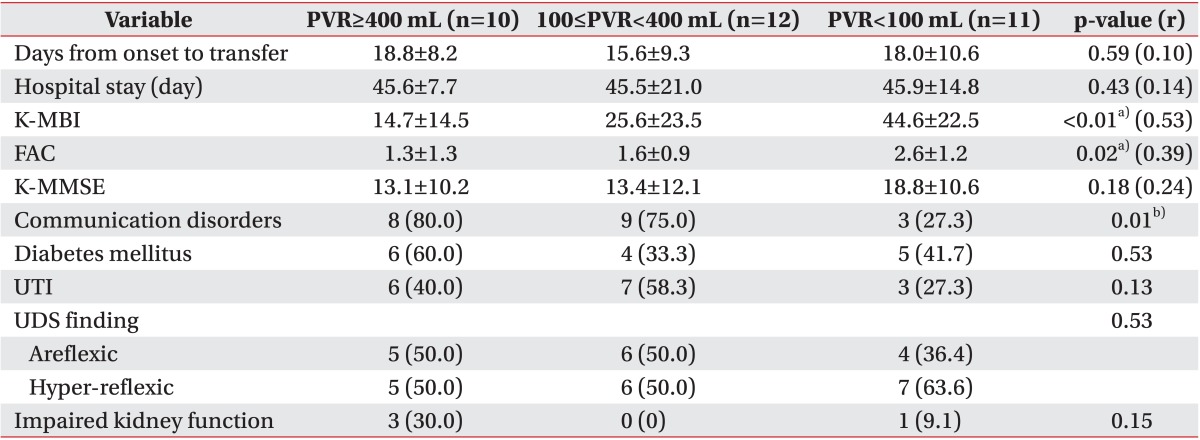1. Brittain KR, Perry SI, Peet SM, Shaw C, Dallosso H, Assassa RP, et al. Prevalence and impact of urinary symptoms among community-dwelling stroke survivors. Stroke. 2000; 31:886–891. PMID:
10753993.

2. Burney TL, Senapati M, Desai S, Choudhary ST, Badlani GH. Acute cerebrovascular accident and lower urinary tract dysfunction: a prospective correlation of the site of brain injury with urodynamic findings. J Urol. 1996; 156:1748–1750. PMID:
8863586.

3. Gelber DA, Good DC, Laven LJ, Verhulst SJ. Causes of urinary incontinence after acute hemispheric stroke. Stroke. 1993; 24:378–382. PMID:
8446973.

4. Kong KH, Young S. Incidence and outcome of poststroke urinary retention: a prospective study. Arch Phys Med Rehabil. 2000; 81:1464–1467. PMID:
11083349.

5. Garrett VE, Scott JA, Costich J, Aubrey DL, Gross J. Bladder emptying assessment in stroke patients. Arch Phys Med Rehabil. 1989; 70:41–43. PMID:
2916918.

6. Meng NH, Lo SF, Chou LW, Yang PY, Chang CH, Chou EC. Incomplete bladder emptying in patients with stroke: is detrusor external sphincter dyssynergia a potential cause? Arch Phys Med Rehabil. 2010; 91:1105–1109. PMID:
20599050.

7. Kim HL, Kim JC, Benson DA, Bales GT, Gerber GS. Results of treatment with tamsulosin in men with acute urinary retention. Tech Urol. 2001; 7:256–260. PMID:
11763483.
8. Buckley BS, Lapitan MC. Drugs for treatment of urinary retention after surgery in adults. Cochrane Database Syst Rev. 2010; (10):CD008023. PMID:
20927768.

9. Thomas LH, Cross S, Barrett J, French B, Leathley M, Sutton CJ, et al. Treatment of urinary incontinence after stroke in adults. Cochrane Database Syst Rev. 2008; (1):CD004462. PMID:
18254050.

10. Coombes GM, Millard RJ. The accuracy of portable ultrasound scanning in the measurement of residual urine volume. J Urol. 1994; 152(6 Pt 1):2083–2085. PMID:
7966680.

11. Goode PS, Locher JL, Bryant RL, Roth DL, Burgio KL. Measurement of postvoid residual urine with portable transabdominal bladder ultrasound scanner and urethral catheterization. Int Urogynecol J Pelvic Floor Dysfunct. 2000; 11:296–300. PMID:
11052565.

12. Jung HY, Park BK, Shin HS, Kang YK, Pyun SB, Paik NJ, et al. Development of the Korean version of Modified Barthel Index (K-MBI): multi-center study for subjects with stroke. J Korean Acad Rehabil Med. 2007; 31:283–297.
13. Cunha IT, Lim PA, Henson H, Monga T, Qureshy H, Protas EJ. Performance-based gait tests for acute stroke patients. Am J Phys Med Rehabil. 2002; 81:848–856. PMID:
12394997.

14. Kang Y, Na DL, Hahn S. A validity study on the Korean Mini-Mental State Examination (K-MMSE) in dementia patients. J Korean Neurol Assoc. 1997; 15:300–308.
15. Levey AS, Bosch JP, Lewis JB, Greene T, Rogers N, Roth D. A more accurate method to estimate glomerular filtration rate from serum creatinine: a new prediction equation. Ann Intern Med. 1999; 130:461–470. PMID:
10075613.

16. Maru A. Cystometry and urethral pressure profilometry after cerebral stroke (author's transl). Nihon Hinyokika Gakkai Zasshi. 1980; 71:171–183. PMID:
7382230.
17. Park HW, Shin YB, Sohn HJ, Chang JH, Ha YH, Moon HJ, et al. Urodynamic findings and voiding symptoms according to lesionsites in stroke. J Korean Acad Rehabil Med. 2009; 33:36–40.
18. Ween JE, Alexander MP, D'Esposito M, Roberts M. Incontinence after stroke in a rehabilitation setting: outcome associations and predictive factors. Neurology. 1996; 47:659–663. PMID:
8797460.
19. Brocklehurst JC, Andrews K, Richards B, Laycock PJ. Incidence and correlates of incontinence in stroke patients. J Am Geriatr Soc. 1985; 33:540–542. PMID:
4019999.

20. Badlani GH, Vohra S, Motola JA. Detrusor behavior in patients with dominant hemispheric strokes. Neurourol Urodyn. 1991; 10:119–123.

21. Leuck AM, Wright D, Ellingson L, Kraemer L, Kuskowski MA, Johnson JR. Complications of Foley catheters: is infection the greatest risk? J Urol. 2012; 187:1662–1666. PMID:
22425122.





 PDF
PDF ePub
ePub Citation
Citation Print
Print



 XML Download
XML Download